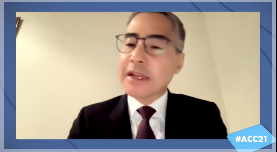Key Points:
- Among patients with suspected acute coronary syndromes (ACS) and ischemia excluded on an initial electrocardiogram, randomized allocation of unmasked hs-cTnT within a 0/1-hour protocol as opposed to a 0/3-hour protocol with troponin T results masked at <29 ng/L was associated with:
- Reduction in functional stress testing
- Increase in coronary angiography and revascularization
- Unmasked reporting of hs-cTnT was not associated with a reduction in late death or myocardial infarction (MI) over 12 months of follow up
- Among those presenting with troponins within the masked range (≤29 ng/L), a significant increase in death or MI emerged within 12 months of follow up
Cardiac troponins have been well established as the diagnostic biomarkers of myocardial injury in the context of ACS. Fifth-generation high-sensitivity cardiac troponin (hs-cTnT) assays have been developed and are now in widespread use. The newer hs-cTnT has increased the ability to reliably rule out patients, particularly those who are low-risk, for suspected ACS at the expense of specificity. For example, cardiac diseases other than ACS events such as myocarditis, Takotsubo cardiomyopathy, or shock can produce increased levels of troponin, so the test must be interpreted in the correct clinical context. The goal is that hs-cTnT allows emergency department physicians to rapidly rule-in or rule-out patients with chest pain in order for patients to be more efficiently stratified and potentially safely discharged, thereby avoiding needless expenditure. More information is needed however to establish the safety and efficiency of the new hs-cTnT protocols.

According to Dr. Kristin Newby, Professor of Medicine in the division of cardiology and co-director of the CCU at Duke University Medical Center, and a discussant for the Rapid Assessment of Possible ACS in the Emergency Department with High Sensitivity Troponin T (RAPID-TnT trial) at ACC’s Late Breaking Trials Deep Dive Discussion on May 16th, “This randomized trial was the exact trial that needed to be done.” The RAPID-TnT trial (Rapid Assessment of Possible ACS in the Emergency Department with High Sensitivity Troponin T), led by investigator Derek Chew, MBBS, MPH, PhD of Flinders University in Adelaide Australia, was particularly important because the impact of hs-cTnT on late outcomes as a result of change in acute care practices has not been fully evaluated in patient-level randomized clinical trials.
The design of the initial RAPID-TnT trial was a prospective patient-level randomized noninferiority evaluation of a 0/1-hour protocol using an unmasked hs-cTnT–reporting format in comparison with a 0/3- hour testing protocol with troponin T results masked at <29 ng/L. The group with hs-cTnT testing at hour 0 and hour 3 were considered to be the standard care group, where masking of troponin levels <29 ng/L was in accordance with standard practice at the time and subsequent care of patients noted to be at the treating physician’s discretion. The intervention arm, with hs-cTnT at hour 0 and hour 1, was also known as the unmasked arm since physicians had access to hs-cTnT levels as low as 5 ng/L. In the unmasked arm, physicians categorized patients as rule-in (treat as ACS), rule-out (with ACS probability <1%) or further observation (ACS probability 25%). Participants in this trial were patients who presented to any of 4 metropolitan centers in South Australia with suspected ACS but no definitive evidence of coronary ischemia on electrocardiogram.
The 30-day results, published in Circulation in 2019 , included 3,378 patients (mean age, 59 years; 53% men) who visited EDs in South Australia. It showed that the 0/1-hour protocol enabled more rapid discharge of patients with suspected ACS and decreased functional cardiac testing. There was a significant increase in coronary angiography and coronary revascularization in the 0/1-hour hs-cTnT arm. Overall, the 0/1-hour hs-cTnT protocol was found to not be inferior to standard care, although an increase in myocardial injury was observed. The 30-day results also established the safety of this new protocol, as patients discharged from the ED with the 0/1-hour protocol had a negative predictive value of 99.6% (95% CI, 99.0–99.9%) for 30-day death or myocardial infarction.
At ACC 2021 on May 16th, Dr. Chew presented the results of the 1-year data for the RAPID-TnT study. The key study question was to evaluate the impact of the superior reporting precision of hs-cTnT assays when incorporated into a rapid 0/1-hour protocol in terms of all-cause death or myocardial infarction (MI), which was adjudicated against the 4th Universal Definition of MI. In order to answer this question, the study investigators sough to determine the effectiveness of care informed by the 0/1-hour hs-cTnT unmasked reporting within 12 months. Ultimately 3,270 patients (n=1,632 masked and n=1,638 unmasked) had data available for 1-year follow-up. The majority of these patients (91.5%) were noted to have hs-cTnT > 29ng/L.
The primary outcome, a composite of all-cause mortality and MI, was not significantly different amongst the two groups (5.01% in 0/1-hour arm vs. 3.8% in 0/3-hour arm, HR = 1.32; 95% CI: 0.95-1.83; P = 0.1), though the 0/1-hour unmasked hs-cTnT arm saw a numerically higher rate of these events (82/1638 [5.01%] in 0/1-hour arm vs. 62/1632 [3.8%] in 0/3-hour arm). In subgroup analysis of patients with troponin <29 ng/L, it was noted that amongst patients within the unmasked hs-cTnT <29 ng/L group, there was a statistically significant increase in the composite outcome compared to patients in the 0/3-hour masked hs-cTnT arm (55/1486 [3.7%] vs. 34/1507 [2.3%], respectively) which persisted after adjustment for baseline differences (HR 1.60, 95% CI: 1.05-2.46, p = 0.03). Secondary clinical outcomes included unplanned hospital admission for non-coronary cardiovascular diagnoses (specially arrythmia, heart failure, stroke or transient ischemic attack, or peripheral vascular disease) within 12 months, which was similar in both groups (4.0% in 0/1-hour arm vs. 3.9% in 0/3-hour arm, HR 1.03, 95% CI: 0.69-1.55, p = 0.881).

Limitations to the study included no overall difference between study arms using the intention to treat population, therefore the cause of the signal for excess harm in the unmasked 0/1-hour hs-cTnT group remains unknown. In an interview with Dr. Newby for CardiologyNowNews, she acknowledged that this finding may have been due to chance alone. She questioned, however, whether the additional clinical information associated with the unmasking of the ≤29 ng/L troponin group led to additional workup that caused more harm. She noted that this signal is perplexing and “may cause the international community to think more carefully about implementing these rapid rule outs.” In his presentation, Dr. Chew remarked that going forward, his team is considering extending this trial longer than one year to further investigate. Dr. Chew’s work is simultaneously published in Circulation .



Leave a Reply
You must be logged in to post a comment.